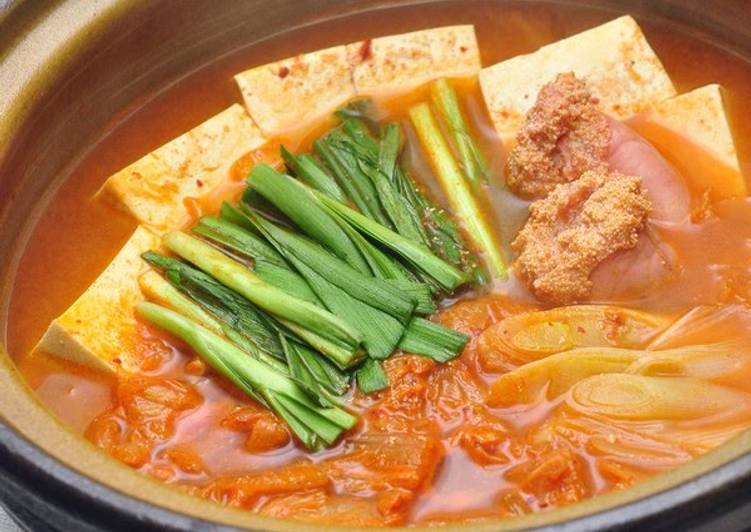Korean Cuisine - Kimchi Jjigae with Tarako. Heat vegetable oil in a pot, and slowly stir-fry the kimchi including the marinade sauce over medium heat. Cut the tofu into large pieces, and add to the pot. Korean Cuisine - Kimchi Jjigae with Tarako Hey everyone, it is Jim, welcome to our recipe site.
 This is gonna smell and look delicious.
The ultra comforting Korean stew - Kimchi Jjigae recipe!
When kimchi gets old, it becomes an excellent ingredient for various other dishes!
You can have Korean Cuisine - Kimchi Jjigae with Tarako using 7 ingredients and 5 steps. Here is how you achieve that.
This is gonna smell and look delicious.
The ultra comforting Korean stew - Kimchi Jjigae recipe!
When kimchi gets old, it becomes an excellent ingredient for various other dishes!
You can have Korean Cuisine - Kimchi Jjigae with Tarako using 7 ingredients and 5 steps. Here is how you achieve that.
Ingredients of Korean Cuisine - Kimchi Jjigae with Tarako
- You need 200 grams of Chinese cabbage kimchi (including the marinade sauce).
- It's 1 block of Silken tofu.
- It's 2 of Tarako.
- Prepare 4 of Chinese chives.
- Prepare 1/2 of Japanese leek.
- You need 1 clove of Garlic.
- It's 1200 ml of Bonito dashi soup stock.
The most common dish made with aged kimchi is kimchi jjigae (김치 It's a go-to stew in Korean homes. Korean Cuisine - Kimchi Jjigae with Tarako is one of the most favored of current trending meals on earth. It is enjoyed by millions daily. Kimchi Jjigae (김치찌개) also known as Kimchi stew or Kimchi soup is probably the most common way of consuming some aged Kimchi.
Korean Cuisine - Kimchi Jjigae with Tarako step by step
- Heat vegetable oil in a pot, and slowly stir-fry the kimchi including the marinade sauce over medium heat..
- After 3-4 minutes of stir-frying, pour the bonito dashi soup stock into the pot. Add the grated garlic as well, and simmer for 6-7 minutes..
- Cut the tofu into large pieces, and add to the pot..
- Add the tarako as is or cut in half and add to the pot. Cut the Japanese leek on the diagonal into thin slices, and add to the pot..
- Simmer for 2-3 minutes, add the Chinese chives, and turn off the heat..
It is a such a staple food in Korean households that typically Koreans would eat it at least once or twice a week if not more! To make kimchi jjigae (TCHEEgeh), you really should use ripe (as in sour) kimchi. You could make it with the fresh stuff, but that's not what this dish was invented for, which was to get rid of the kimchi that's been fermenting just a little too long when you've got huge earthenware jars full of. Other elements usually include diced tofu, pork, or seafood, along with scallions and other vegetables such as potatoes or zucchinis. Kimchi For good kimchi jjigae, you need over-fermented (sour) kimchi.